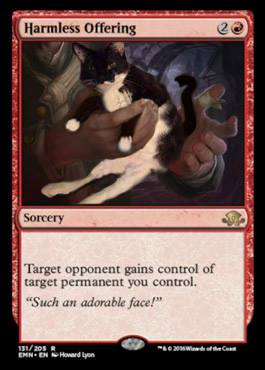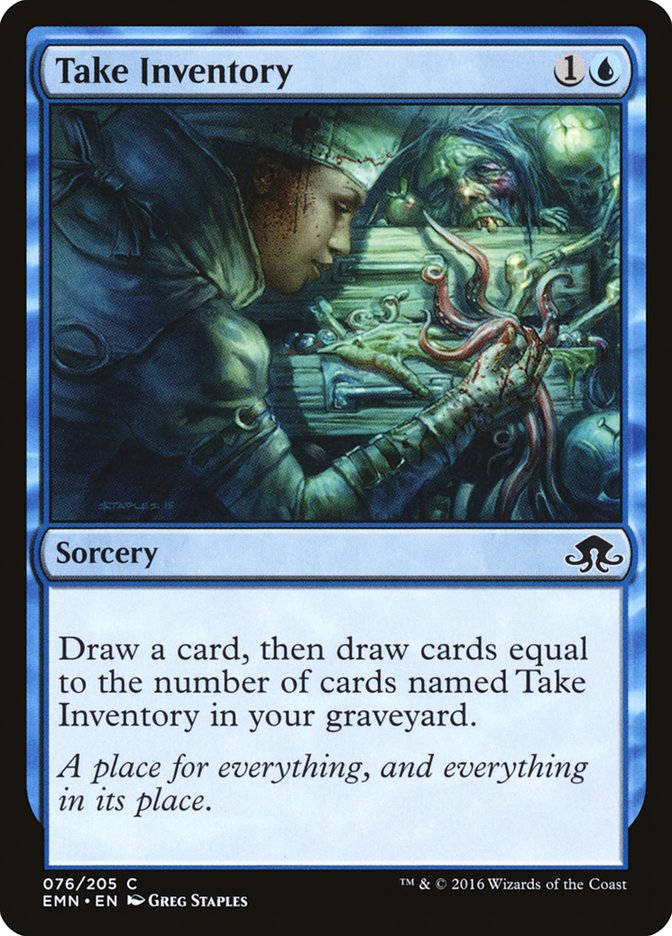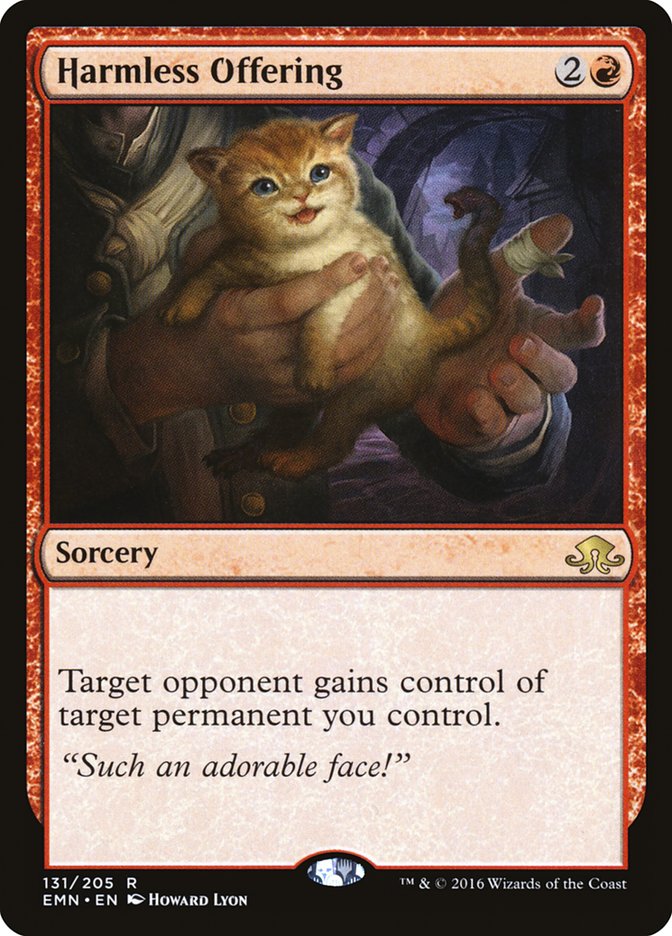Everyone has pet cards.

Image credit: Michelle Pedro.
Okay. That’s pun #1. Straps yourselves in, kiddies. There might be a lot of them today.
For those of you not familiar, I love my cats. I have three. They are my babies, and I will probably eschew having children because:
1. I hate children.
2. I love cats.
That sums it up quite nicely.
It’s safe to say that when Harmless Offering was spoiled I immediately went to work on devising new Standard decks to abuse it. Donate, for those of you who didn’t play many years ago or are just getting into Magic, is one of the single most dominant and polarizing strategies ever created, in combination with cards like Necropotence, Demonic Consultation, and Illusions of Grandeur.
The gameplan was simple:
· Illusions of Grandeur would give you a gigantic life cushion.
· Abuse that life gain with Necropotence and draw a gratuitous amount of cards.
· Demonic Consultation assured you’d find your pieces.
· Donate Illusions of Grandeur to your opponent.
· Watch in awe as cumulative upkeep killed them.
This deck didn’t just dominate; it utterly warped the metagame. The first iteration of it involved the banning of Dark Ritual and Mana Vault to hopefully tone down the power level, but it was all for naught. Another version with Mox Diamond emerged to slaughter Grand Prix and Pro Tour Qualifiers. Eventually it became Mono-Blue and enjoyed success with Intuition / Accumulated Knowledge / Sapphire Medallion / Frantic Search / Merchant Scroll.
Nowadays, Donate is enjoying its time away from Magic by relaxing on the sandy beaches of the Reserved List, never to be printed again.
Until now!
The shifting of Donate from blue to red has begotten Harmless Offering. The functional reprint that does a lot more than just win you the game.
First and foremost, Harmless Offering proves that Wizards of the Coast are well aware of the restrictions placed on them by the Reserved List, but there is nothing in the fine print that prohibits them from color shifting those cards. In truth, it completely changes the identity of the card, what spells you can play alongside it, and exactly how threatening it can be. Would Donate have been the scourge of pre-Sixth Edition had it been red and not blue? It’s likely that wouldn’t have been the case, but this does mean something very important.
As cards become more scarce years from now, these functional reprints may become the savior of Magic. On his Tumblr, Mark Rosewater expressed “remember the new cards have to be in modern color pie and be of a printable power level” when asked about Harmless Offering. He also addressed multiple concerns over the card, especially the power level of Donate, and said that it has been tested plenty and that it appeared to be well within that “reasonable power level.” I urge you to check out his musings for yourself in order to gain a deeper understanding.
When I hear something is tested, though, I never really believe that it can’t be broken. In the last decade we’ve heard everything from “Skullclamp was fine in early testing” to “Affinity didn’t seem like it would be a busted mechanic” to “Dig Through Time and Treasure Cruise appeared safe.” What I’m trying to say is that the Magic community has the best and brightest minds working around the clock to snap an archetype in two.
Within minutes of it being spoiled, I was inundated with messages about Harmless Offering. My love of my cats stretches far and wide and is likely the stuff of fables. I think I fall just short of those people that are obsessed with Sonic the Hedgehog.
Brennan DeCandio, my lifemate and #SCGORL Top 4 competitor, sent me a message right as I was sending him a message with a decklist featuring Harmless Offering. Best buds, etc. etc. etc.
We went two different ways, but it goes to show you just how diverse this type of deckbuilding really is. While they both are revolve around Harmless Offering and Demonic Pact (the most obvious interaction), each of us wanted different things out of our deck.
First, I’ll show you Brennan’s take.
Planeswalkers (7)
Lands (26)
Spells (27)

Brennan opted for the Mardu route, and I think it stands out as a very powerful deck right out of the gate. With the format becoming as entrenched in out-resourcing the opponent, conveniently there are very few ways to interact with Demonic Pact. The most obvious offender is going to be Dramoka’s Command, but this deck doesn’t actually need it to win. It has tremendous battlefield-clearing capabilities; extremely consistent win conditions in Chandra, Flamecaller and Nahiri, the Harbinger; and the ability to search up the needed pieces with Dark Petition.
It is possible Dark Petition should be higher in numbers, but between Nahiri, Read the Bones, the draw from Demonic Pact, and Ob Nixilis Reignited, this deck shouldn’t have too much trouble putting the parts together. Nahiri is our built-in insulation from losing to Pact, as her ability to exile enchantments acts two-fold:
1. Exiling Demonic Pact before it kills us.
2. Exiling Evolutionary Leap before it kills us.
The sideboard is stocked with more versatile cards. Infinite Obliteration and an additional Dark Petition are for Ramp strategies. Transgress the Mind is quietly the best disruption spell in all of Standard and shouldn’t require much explanation. Kalitas, Traitor of Ghet pairs very well with all the removal, including the Dead Weights that come in against R/W Humans along with an additional Radiant Flames. Anguished Unmaking is a catch-all, and can even remove your Pact if you’re in a pinch. Sorin, Grim Nemesis is never a bad card to lean on.
One plan we brought up is the possibility of sideboarding a full set of Hanweir Garrison, since almost every midrange or control opponent will be sideboarding out their creature removal because you play zero in your maindeck. This Goblin Rabblemaster approach might be good, depending on how the format leans. They also allow you quick ways to close out post-sideboard games if the first went long. For now they didn’t make the cut, but it’s possible they are correct to play when we see how things shape up.
Next up is what I sent Brennan.
I took a Grixis approach to the deck based on the ability to recur Harmless Offering if it becomes countered, or even the means to bounce your own Demonic Pact.
Creatures (6)
Lands (26)
Spells (28)

Grixis gives us Silumgar’s Command, which is the most underrated and least played of all the Commands. The bounce on it is invaluable, but it also helps power out tremendous blowouts against your opponents. It does so much work in this deck, and like The Dude’s rug in The Big Lebowski…it really ties the room together. Jace and Goblin Dark-Dwellers give us reoccurring sources to continue casting Harmless Offering along with all the other spells in our deck. Like the Mardu version, we choose Duress in the main over the slightly superior Transgress the Mind to protect against Dramoka’s Command. The rest of the removal in the deck handles the other threats that couple hinder your deck.
Summary Dismissal is the counterspell control has been waiting for and handles a lot of issues that these decks have with Ramp strategies or, in particular, Ulamog, the Ceaseless Hunger or World Breaker. It has the ability to keep a World Breaker from coming back or taking out a creature-land. The same applies for Ulamog.
The rest of the sideboard is very similar to the Mardu deck, because they both share a card pool and important black and red spells. Negate out of the sideboard is a great tool for all the noncreature spells that exist in the format today, from Collected Company to Explosive Vegetation, Part the Waterveil and everything in between.
Both decks have their strong points and I’d be considering them for your testing rackets. I’m sure there are even Jund versions that can exist that maximize planeswalkers and Naturalize effects to kill your own Pact. I’m sure it’s out there; I just haven’t explored it yet.
The biggest reason I wanted to talk about Harmless Offering today, though, isn’t because I’m excited to have seen it printed. It comes down to the fact that it is the kind of card people immediately write off as “bad.” I’ve seen tons of complaining this week about “awful” versions of cards.
Both cards existed in an entirely different time in Magic, and hilariously in the same deck at one point, but were successful because of the cards around them. Accumulated Knowledge, for example, was incredible because it was in decks with Intuition, Psychatog, Wild Mongrel, or Sapphire Medallion. Being an instant, for the most part, wasn’t much of an issue, because a lot of Accumulated Knowledges were cast in main phases to hit land drops and increase velocity.
Eldritch Moon has provided two very good cards that should see a fair bit of play, but today was more about the act of testing out these new cards to see what kind of viability they have. Far too often players want to seem like they know what they’re talking about when, in fact, they don’t. They make baseless claims about a cards playability without any testing, theorycrafting, or even attempts to see what rests beneath the surface.
Everybody wants to be the smartest person in the room and everybody wants to be able to say “I told you so.” Failing with a brew or a new pet card is fine; you learned something. You become a better deckbuilder by experiencing different strategies and working out different cards. Never trying just so you can say you were right all along? That’s not how you grow. That’s how you stay weak and never grow as a player.
As for me, I’ll be trying out other Harmless Offering decks to see what else is out there.
Also on the list?
· Take Inventory U/B Prison with Emrakul, the Promised End
· Bant Delirium with Tamiyo, Field Researcher
· Revisiting R/B Vampires with Stromkirk Condemned
· R/W Humans with Hanweir Garrison
And that’s just the tip of the iceberg. There are plenty more things trapped in that ice.
I told you. Puns.



